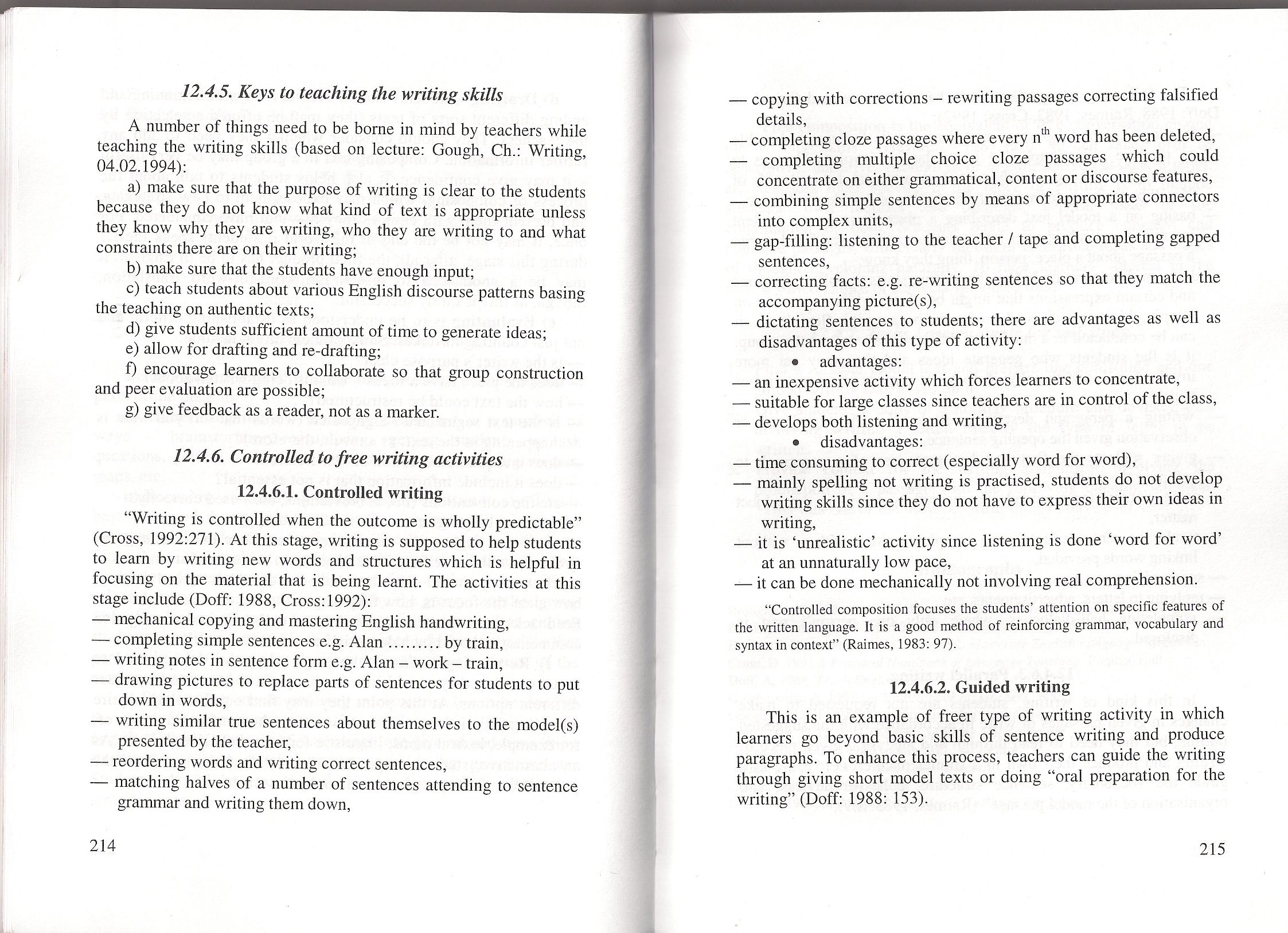skanowanie0107 (2)

12.4.5. Keys to teaching the writing skills
A number of things need to be borne in mind by teachers while teaching the writing skills (based on lecture: Gough, Ch.: Writing, 04.02.1994):
a) make surę that the purpose of writing is elear to the students because they do not know what kind of text is appropriate unless they know why they are writing, who they are writing to and what constraints there are on their writing;
b) make surę that the students have enough input;
c) teach students about various English discourse pattems basing the teaching on authentic texts;
d) give students sufficient amount of time to generate ideas;
e) allow for drafting and re-drafting;
f) encourage leamers to collaborate so that group construction and peer evaluation are possible;
g) give feedback as a reader, not as a marker.
12.4.6. Controlled to free writing activities
12.4.6.1. Controlled writing
“Writing is controlled when the outeome is wholly predictable” (Cross, 1992:271). At this stage, writing is supposed to help students to leam by writing new words and structures which is helpful in focusing on the materiał that is being leamt. The activities at this stage include (Doff: 1988, Cross: 1992):
— mechanical copying and mastering English handwriting,
— completing simple sentences e.g. Alan.........by train,
— writing notes in sentence form e.g. Alan - work - train, drawing pictures to replace parts of sentences for students to put down in words,
— writing similar true sentences about themselves to the model(s) presented by the teacher,
— reordering words and writing correct sentences,
— matching halves of a number of sentences attending to sentence grammar and writing them down,
— copying with corrections - rewriting passages correcting falsified details,
— completing cloze passages where every n* word has been deleted,
— completing multiple choice cloze passages which could concentrate on either grammatical, content or discourse features,
— combining simple sentences by means of appropriate connectors into complex units,
— gap-filling: listening to the teacher / tape and completing gapped sentences,
— correcting facts: e.g. re-writing sentences so that they match the accompanying picture(s),
— dictating sentences to students; there are advantages as well as disadvantages of this type of activity:
• advantages:
— an inexpensive activity which forces leamers to concentrate,
— suitable for large classes sińce teachers are in control of the class,
— develops both listening and writing,
• disadvantages:
— time consuming to correct (especially word for word),
— mainly spelling not writing is practised, students do not develop writing skills sińce they do not have to express their own ideas in writing,
— it is ‘unrealistic’ activity sińce listening is done ‘word for word’ at an unnaturally Iow pace,
— it can be done mechanically not involving real comprehension.
“Controlled composition focuses the students’ attention on specific features of
the written language. It is a good method of reinforcing grammar, vocabulary and
syntax in context” (Raimes, 1983: 97).
12.4.6.2. Guided writing
This is an example of freer type of writing activity in which leamers go beyond basie skills of sentence writing and produce paragraphs. To enhance this process, teachers can guide the writing through giving short model texts or doing “orał preparation for the writing” (Doff: 1988: 153).
215
Wyszukiwarka
Podobne podstrony:
skanowanie0107 (2) 12.4.5. Keys to teaching the writing skills A number of things
skanowanie0107 (2) 12.4.5. Keys to teaching the writing skills A number of things
The Writing Skills Teaching of this skill should proceed through controlled, guided to free writing
The Writing Skills Teaching of this skill should proceed through controlled, guided to free writing
skanowanie0021 (22) children, and that adult classroom learning therefore has to be designed in a di
mb 29 MUSCLS BUILDING, 29 is to escrcise and dewlop tlić npjjor arm. The hand is to be placed in a s
ADMIRALTY NOTICKS TO MARINERS - ELECTRONIC COURIBK SKRVIC.ES The UKHO licenses a number of commercia
« —.7 rSA-X. HIGH BI AS IS RICHER FOR IT. The greatest honor a cassette can receive is to be held in
Ufi - h ii" *TO*Xr gramming algorithm allows the 27C128 to be programmed in less than 2 sec-ond
1.1 Local Area Networks The type of Computer network to be studied in 1.1 is a single isolated LAN w
MR293R190?3 1 PREPARAT!ON AND PAISTING MKTHOD HO REPAIRS POSSIBLE Ali fittings to be painted in the
- Poetry was to be found in the Bibie: the resource of samts and angel1. -
47267 MR293R190?3 1 PREPARAT!ON AND PAISTING MKTHOD HO REPAIRS POSSIBLE Ali fittings to be painted i
więcej podobnych podstron